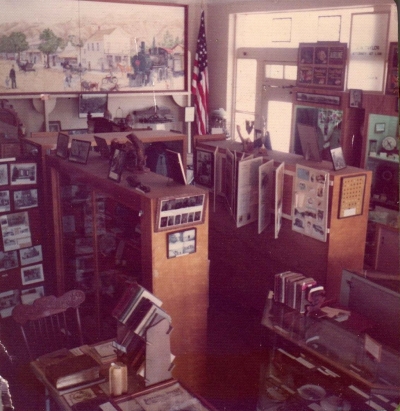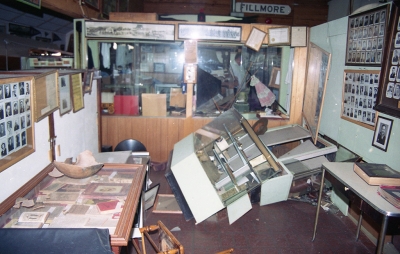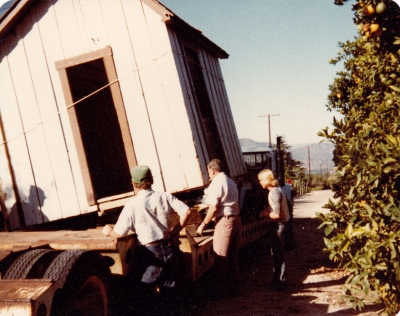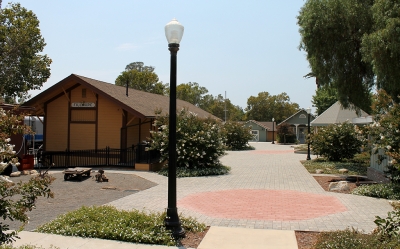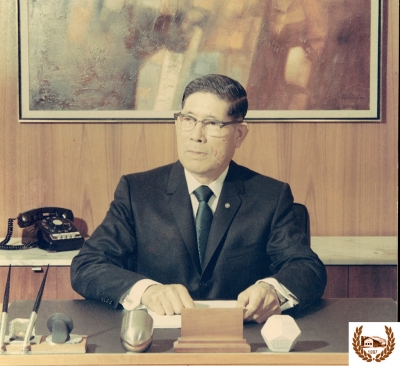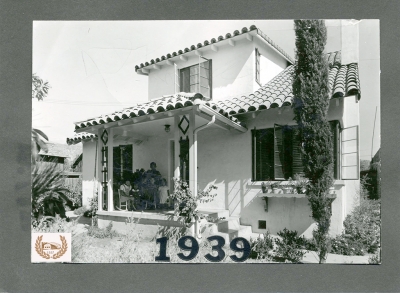|
By Gazette Staff Writers — Wednesday, October 27th, 2021
The Ventura County Public Health Officer has extended the indoor mask order, requiring all individuals, regardless of vaccination status, to wear face coverings when indoors in public settings, with limited exceptions. “The order is necessary to reduce the rate of community spread and to reinforce the need for safe interactions. We will continue to monitor transmission rates, hospitalizations, deaths and vaccination rates throughout the County,” said Public Health Officer Doctor Robert Levin. The order will continue to be in effect until: (2) COVID-19 hospitalizations in the County are low and stable, in the judgment of the Health Officer; and (3) eight weeks have passed since a COVID-19 vaccine has been authorized for emergency use by federal and state authorities for 5 to 11-year-olds or 80% of the County’s eligible population is fully vaccinated with two doses of Pfizer or Moderna or one dose of Johnson & Johnson (booster doses not considered); Or until the Order is extended, rescinded, superseded or amended in writing by the Health Officer. The order directs that face coverings must be worn over the mouth and nose – regardless of vaccination status – in all indoor public settings, venues, gatherings, and workplaces, including but not limited to offices, retail stores, restaurants and bars, theaters, family entertainment centers, conference and event centers, and government offices serving the public. Performers at indoor live events such as theater, opera, symphony, and professional sports and persons speaking before a live audience may remove face coverings while actively performing or participating, though such individuals should practice physical distancing as much as practicable. Further amendment and clarification to the Order may be set forth in the County of Ventura’s FAQs. Due to the quickly evolving nature of local health conditions and State orders, the Health Officer has determined that the public would be best served by utilizing FAQ’s that can be easily accessed by members of the public and quickly updated by the Health Officer as circumstances warrant. Therefore, all FAQs on the County of Ventura website at www.vcrecovers.org shall be deemed a directive of the Health Officer. |
 Dorothy Haase, Fillmore Historical Museum cofounder, who was in charge until 1996. Photos courtesy Fillmore Historical Museum. Enlarge Photo By Gazette Staff Writers — Wednesday, October 27th, 2021
Courtesy Fillmore Historical museum The museum has been in Fillmore for decades but how did it get started? In 1970 the Fillmore Chamber of Commerce under the direction of its president, Joe Kern, decided that Fillmore needed a museum. There had been a small historical display in the 1940s located in the Fillmore City Hall. City Manager Clarence Arrasmith was custodian of this small collection of artifacts donated in 1928 by longtime resident, Dr. Alexander McGregor. A real museum would be tourist draw and a source of pride for the community. The Chamber Board asked local author, historian and Spanish teacher, Edith Jarrett, to spearhead the project and become the founding curator. In addition the Chamber donated $1000 to get the project rolling. Edith along with Dorothy Haase who was Chamber secretary began the process by finding a rental space for the future museum. The first location would be the ground floor space in the Masonic Temple Building on the corner of Central and Sespe Streets. Over the years this space had been a general merchandise store and a grocery store. It would soon become the Fillmore Historical Museum and would share space with the Chamber of Commerce. But how do you start a museum from scratch? The first item on the agenda was making a list of about 100 families who had been in Fillmore as early as 1900. Dorothy and Edith drafted a letter which was sent to these families and to local clubs and civic groups explaining the new project and its need for financial help as well as historic artifacts. Then the wait for a response began. The response was incredible. They received hundreds of photos, old oil field and farming tools, kitchen items, paintings and much much more including financial donations. In order to organize and display all these donated items they needed showcases and an identification system. Local families and organizations sent financial donations large and small to cover the cost of the cases. In return a plaque was put on the cases honoring the donor. Carpentry was done by Fred Barger. Earl Ball designed and built the original cases. As time went by and more cases were needed. Some came from local stores who were replacing them with newer ones or they were purchased. Many of the showcases in use today were donated to the Fillmore Museum by the Museum of Ventura County when they replaced them with newer ones. Identification was a simple numbering system with a three digit family number followed by an item number attached to each artifact. The official opening day was during the May Festival in 1972. Within a short time the Museum was receiving visitors by the busload from Los Angeles, students from our local elementary and high schools and numerous clubs and even college students doing research. In 1973 Edith was getting suggestions from the locals that the Museum should acquire the Southern Pacific depot which was going to be torn down by the railroad. At the same time the little space in the Masonic building was to be made even smaller by the installation of an elevator. She took a close look at the depot and found it to be in generally good shape except that there was no wall covering, no ceiling and a splintery floor. It looked every bit its age as it had been built in 1887. It would also need new electrical wiring, plumbing, new paint and, possibly, a new roof. Edith proposed to the city that she would cover the cost of moving, repairs and refinishing if the City would provide a location. Unfortunately, when Edith presented the idea to the city council there was a catch. They had to approve the proposal that night, December 11, 1973, as the Southern Pacific required that the depot must be off the railroad right of way by Dec 31 or it would be demolished. We will be forever grateful that the Fillmore City Council under the leadership of Mayor Ernie Morales unanimously approved the plan that night. The Fillmore Depot was moved to city property on Main St. just across the alley from the old fire station and restored. In 1975, a 1956 boxcar was added to the site for additional display space. Edith served as curator until 1979 succeeded by Dorothy Haase who was in charge until about 1996. The Northridge earthquake of 1994 set the Museum on a new path. The depot was knocked askew off its foundation and the Museum was closed for about four years. During that time the city once again favored the Museum with permission to move to city owned property next to the track on Main St. between Saratoga and Clay. During that 4 years the Museum office was first in a caboose next to the site and then in 1996 the office opened in the 1905 Hinckley House. The house had been badly damaged in the earthquake, donated to the museum by the Corl family, and moved to the new site and restored. The 1919 Bunkhouse building, a donation by James P. Finch, was moved from Rancho Sespe to the site and restored in 1998-1999. Finally the depot which had been moved in 1994 to the site was put on a foundation and restored. The entire project was finished and move in was complete by 2008. Also added to the site was the Bardsdale post office which had for years sat on the depot dock when the depot was across the site next to the alley. In the last 15 years a 1968 caboose has been added, pavers and landscaping installed in the center of the site, and the well-traveled gazebo put in place. The gazebo had graced the city park west of the museum site, then moved to the vacant space where the Masonic Temple had been located and finally moved to the Museum site. A garage was built next to the Hinckley House to protect and display a 1920 Model A pickup which was restored by Lyn Thomas and his high school auto shop class and taken on the History Channel’s Great Race in 1999. The newest addition to the site will be a display building to house the 1927 American La France fire engine which was used here in Fillmore between 1928 and the early 1950s and donated by a group of former Fillmore firemen who faithfully restored it. Throughout Covid 19 closedowns and reopening the Fillmore Historical Museum docents have been at work. New displays have been designed and put in place. We are also looking forward to celebrating the 50th anniversary of the museum next year. We are grateful to the community for its support and we hope that you will take the time to visit the Museum. We also hope that if you are a lover of antique vehicles, especially fire trucks, you will support the Museum with a donation for the specific purpose of building the firehouse. |
|
By Ventura County Sheriff Department — Wednesday, October 20th, 2021
A 34-year-old Fillmore man was arrested after being identified as an arson suspect. On October 10th, at approximately 11:30 a.m., Fillmore patrol deputies responded to Fillmore High School to assist Fillmore Fire Department with an arson investigation. Their investigation determined someone had attempted to throw a bag that was on fire into an open window of the school. Due to the suspicious nature of the fire, investigators from the Fillmore Police Department and Fillmore Fire Department responded to the location. Investigators reviewed nearby video surveillance and were able to identify the suspect as Eric Manzano. On October 15th, investigators located Manzano at his Fillmore residence and arrested him for the arson. Manzano was transported and booked into the Ventura County Pre-Trial Detention Facility for one felony count of arson and for a California Department of Corrections (CDC) parole hold. Manzano remains in custody with his bail set at $60,000. His court date is set on October 18th. Manzano has a prior conviction for arson and is on CDC parole for arson. Fillmore Police Department is actively investigating several other suspicious fires that occurred between September 9th and October 2nd in the city of Fillmore, town of Piru and unincorporated areas of Santa Paula. The Fillmore Police Department encourages citizens to immediately report suspicious people and vehicles, and to promptly report any crime they come across by calling 911. Nature of Incident: Arson Suspect Arrested Ventura County Crime Stoppers will pay up to $1,000 reward for information, which leads to the arrest and criminal complaint against the person(s) responsible for this crime. The caller may remain anonymous. The call is not recorded. Call Crime Stoppers at 800-222-TIPS (8477). |
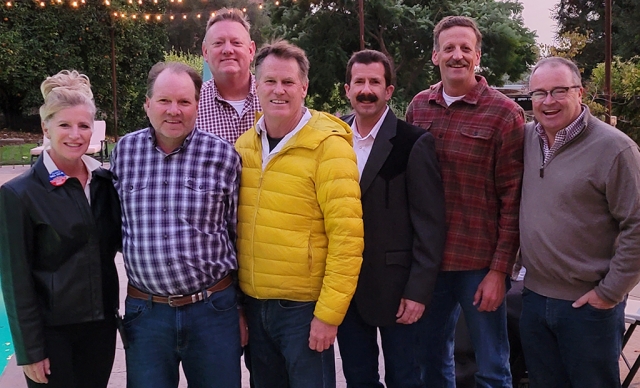 (l-r) Undersheriff Monica McGrath, Scott Beylik, Mike Richardson, Tim Hagel, Ventura County Sheriff Bill Ayub, Eric Tennessen, and Bill Morris. Enlarge Photo By Gazette Staff Writers — Wednesday, October 20th, 2021
An enthusiastic get-together to promote the reelection of Ventura County Sheriff Bill Ayub took place recently at the Mike Richardson ranch in Fillmore. Among approximately 60 honored guests were Undersheriff Monica McGrath, Tim Hagel, Thousand Oaks Chief of Police, ret., Scott Beylik, Bill Morris and Avery Stewart. McGrath reminded the group of the Sheriff's outstanding leadership during one of the largest wild fires on record, and his adroit handling of the November 7, 2018, mass shooting at the Thousand Oaks Borderline Bar and Grill. Both calamities occurred simultaneously in the very first days of his election to the position of Ventura County Sheriff. He received high praise for the effective control he demonstrated at that time. Sheriff Ayub spoke of holding crime rates at historic lows during his tenure as Sheriff during several challenging times. Sheriff Ayub notes: "During my first term, we have held crime rates at historic lows in Ventura County while they have risen elsewhere. I achieved this by seeking out innovative strategies, employing well-trained and well-equipped staff, and fostering strong and supportive relationships with the community." He is also "not accepting endorsements or donations from active duty full-time Ventura County Sheriff’s Office employees." |
|
By Gazette Staff Writers — Wednesday, October 20th, 2021
 This Friday, October 21st, the Fillmore Flashes take on long-time rival Santa Paula for their 110th meeting. Tickets for Friday’s rivalry game are SOLD OUT. However, you can still watch the game live on Friday at the VC Star website. The rivalry is their game of the week. Enlarge Photo |
|
By Gazette Staff Writers — Wednesday, October 20th, 2021
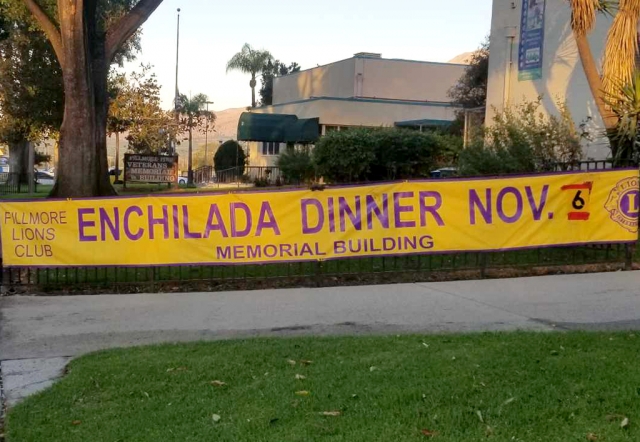 On Saturday, November 6th, the Fillmore Lions Club will be hosting their Annual Enchilada Dinner. Due to COVID-19 this year’s dinner will be drive-thru only, from 5 – 7pm at the Fillmore Veterans Memorial Building. Tickets are on sale now - email fillmorecalionsclub@gmail.com for tickets and further information. Enlarge Photo |
|
By Gazette Staff Writers — Wednesday, October 20th, 2021
Ventura County Sheriff Bill Ayub is announcing the formation of a new program aimed to provide specialized assistance to military veterans who live in our communities who are experiencing a mental health crisis. Sheriff Ayub is pleased to offer the Sheriff’s VOICE program, which stands for Veterans Outreach In Crisis Events. The Sheriff’s Office has been working on developing the program for several months, working with federal and local partners to develop specialized training for our deputies. The program is designed to pair specially trained deputy sheriffs who are military veterans themselves with military veterans in our communities who are experiencing a mental health crisis and who’ve called the Sheriff’s Office for help. Each of the deputy sheriffs participating in the program is a military veteran and volunteered to be part of the program. Many of our deputy sheriffs volunteered because they have personal experiences with veterans they served alongside who have died by suicide, or they served with veterans who struggle daily with mental health issues because of their service to our country. “I applaud Ventura County Sheriff Bill Ayub, and the entire department, for the launch of their new Veterans Outreach In Crisis Events program, or VOICE,” said Congressman Mike Garcia. “This program will enable the department to better serve the veteran community in Ventura County. With the recent chaotic withdrawal in Afghanistan, this program is more important than ever. I want our Global War on Terror veterans, as well as veterans of all generations, to know that their service was not in vain and that our community is here to support them. I look forward to seeing the positive impact this program will provide for our community.” The VOICE deputies will be first responders to a veteran in crisis and will draw upon their personal experiences and specialized training to build rapport and de-escalate crisis situations. The relationship will not stop with the initial contact. Our VOICE deputies will continue to contact the military veteran in the weeks and months following a crisis event to ensure the veteran’s needs are being met, utilizing services of the Department of Veterans Affairs, County of Ventura Veteran Services Office and other non-profit partners. “Ventura County has a very long and rich military history and is the proud home to more than 40,000 veterans,” said Congresswoman Julia Brownley. “I applaud Ventura County Sheriff’s Office for this initiative, which is taking concrete steps to better respond and intervene in incidents where a veteran is in crisis or struggling with their mental health. No one knows the unique circumstances veterans face better than other veterans, who have sacrificed so much in service to our nation. We owe it to all of our veterans to ensure they receive the proper care and critical services that they need.” The deputy sheriffs were joined by sheriff’s dispatchers and sheriff’s chaplains during special training developed in conjunction with the Ventura County Law Enforcement Crisis Intervention Team. Four of the training instructors are military veterans from the Ventura County Veteran Services Office, Department of Veterans Affairs and the Gold Coast Veteran’s Foundation. The other instructors include a psychiatrist and licensed clinical social worker, both from the Department of Veterans Affairs. “A person experiencing a mental health crisis needs empathy and patience, and for a veteran in need, another veteran with training and experience is best equipped to provide both,” Assemblywoman Jacqui Irwin said. “Law enforcement officers are often the first people to respond to these situations, and I commend the VCSO for implementing a program aimed at de-escalating conflict wherever appropriate and possible.” The Sheriff’s Office receives as many as 15 calls per month from a veteran who is suffering from a mental health crisis. The military community has seen a sharp uptick in calls and texts to the veteran’s crisis line in the last two months since the military withdrawal in Afghanistan. Recognizing the significant military population living in areas served by the Sheriff’s Office, Sheriff Ayub said, “Our military veterans and their families have sacrificed so much for our country to ensure that we are safe. They carry invisible battle scars that can have a significant impact on their lives. Our VOICE program is one way for us to give back to our veterans who might experience a mental health crisis. We are eager to start the program and look forward to the positive impact it will have on the military community.” Prepared by: Commander Eric Tennessen |
|
By Gazette Staff Writers — Wednesday, October 20th, 2021
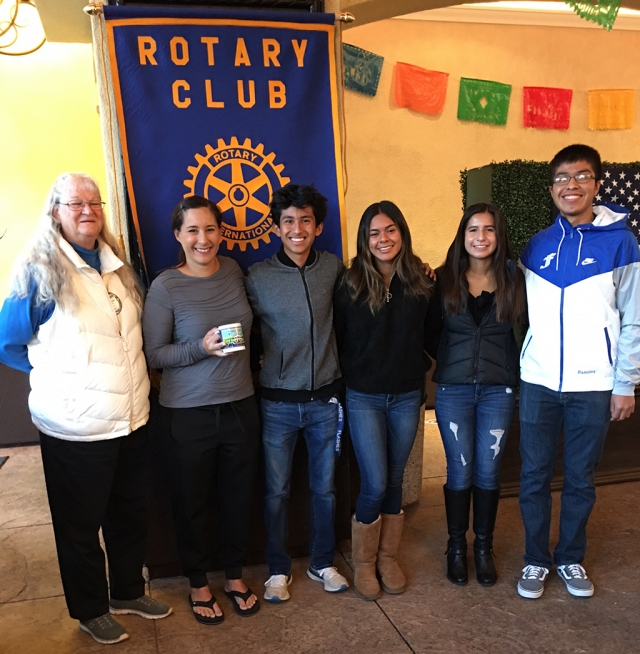 (l-r) Rotarian Cindy Blatt, Athletic Director Kim Tafoya, and four officers from the Fillmore High School Cross Country Team: Michael Camilo Torres, Alianna Tapia, Angelica Herrera and Diego Ramirez, who attended the Rotary meeting last week. Kim stated that these athletes are hard working, train for six months, running with distance between them at practice and must wear masks even when running. They are all committed to do their best in sports and academics. Photo courtesy Rotarian Martha Richardson. Enlarge Photo |
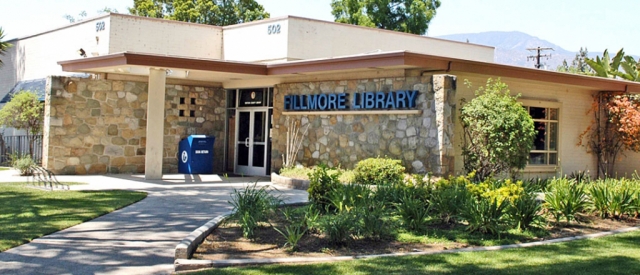 The construction on the Fillmore Library Expansion project is set to begin November 2021. The library will be closed to the public starting October 24, 2021, for an indefinite period of time (most likely 8 months). Until then the County Mobile Library will stop in Fillmore every Tuesday at City Hall. Enlarge Photo By Gazette Staff Writers — Wednesday, October 20th, 2021
Ventura County Library is pleased to announce that construction on the Fillmore Library Expansion project begins in early November 2021. This expansion project effectively doubles the footprint of the current Fillmore Library, meeting the needs of the growing community and providing new services to our Fillmore customers. The newly expanded library includes a classroom, two study rooms, an Innovation/STEAM lab/community meeting room, a designated computer lab with new public computers, new public laptops, useable outdoor areas, new public restrooms, and more. Due to the onsite construction, the Fillmore Library is closed to the public starting October 24, 2021 for an indefinite period of time (most likely about 8 months). To provide services to the Fillmore community during the temporary closure, the Ventura County Mobile Library is making weekly stops at Fillmore City Hall every Tuesday beginning Oct. 5, 2021. This schedule will continue until the expanded Fillmore Library reopens. At the Mobile Library stop customers may pick up holds, return items, get new library cards, participate in outdoor children’s programs such as a weekly Storytime (Tuesdays at 10:30am), browse new materials, and more. Additionally, during the closure, Fillmore customers may use the collections, services, and book drops at any other Ventura County Library (VCL) branch, of which there are 10 open locations throughout the county at this time. The closest VCL branches to Fillmore are: • Piru Library (3811 Center St., Piru 93040) and Our online eLibrary has ebooks, eaudiobooks, and more available for the community to use as well, all accessible 24/7 from your device. We understand this temporary closure of the Fillmore Library is inconvenient to community members, and we are sorry for that inconvenience. We are certain the newly expanded library will have tremendous positive impact in the community. Please visit vencolibrary.org/locations for information on alternative locations to use during the closure period, or vencolibrary.org/library-events for information on the weekly Mobile Library visit to Fillmore. For additional information, contact Nancy Schram, Ventura County Library Director at (805) 256-8535. |
 Inadomi Company store opened back in February 1925, pictured above is a Inadomi Delivery truck circa 1925 which was used to deliver groceries to customers. Photos courtesy Fillmore History Museum. Enlarge Photo By Gazette Staff Writers — Wednesday, October 20th, 2021
 The Inadomi store in 1925, where they sold groceries and other items to the community especially catering to the needs of Spanish speaking customers. Enlarge Photo  (l-r) (back row) Kumanosuke, Monda, & Wari (front row) Kaichiro with Yosh in his lap, Mitsuyo, & Midori. Enlarge Photo Courtesy Fillmore History Museum A house on Main Street, set back from the corner, represents so much more than the security of home and comfort. A well-known and well-loved local family, the Inadomi’s, built it in 1939 before World War II began. Soon it would bear witness to the tragedy of a dark moment in the history of the United States. Still standing over 80 years later it continues to remind us of this terrible event and gives us hope that it never happens again. Kaichiro Inadomi had emigrated from Japan in 1914 to join his father who was working for the Limoneira Ranch in Santa Paula. In 1922 he returned to Japan to marry Mitsuyu Ogawa. They returned to Ventura County where he continued with his job at Limoneira becoming a foreman at the age twenty two. In 1925, looking to improve the future for himself and his family, he decided to purchase a grocery store on Main St. in Fillmore. Because of the existing alien land laws in the U.S., Kaichiro, not being an American citizen, could not own property in this country. He was able to purchase the store with the help of an attorney, a Mr. Tanigoshi who bought the business in his Caucasian American wife’s name and then resold it to Kaichiro’ s American born children Yoshiharu and Taduko who were both under the age of 3 at the time. The Inadomi Company store opened on February 1, 1925. He sold groceries and other items to the community especially catering to the needs of Spanish speaking customers. Kaichiro soon became known as “John” or “Juan” to his Spanish speaking customers. He was active in the community and was a member of the Rotary Club and the Presbyterian Church. Initially the family lived in a “shack” behind the store but it was soon enlarged to shelter his growing family. In 1929 the store was enlarged and rebuilt of brick and in 1939 Kaichiro built a new house beside the store. Today the store is no longer there but the house still stands on the corner of Main St. and Clay St. Following the bombing of Pearl Harbor by the Japanese in 1941 the entire United States was gripped by fear and hysteria. The United States went to war with Germany, Italy, and Japan. On February, 19, 1942, President Roosevelt enacted Executive Order 9066 which allowed for the exclusion of suspect people from the coastal areas of the country. Families up and down both the east and west coasts of German, Italian, and Japanese descent were given a very short time to pack up and turn themselves in. The Inadomi family was included in this order. It is also to be noted that far fewer German and Italian individuals were interned than Japanese. At the time of the bombing of Pearl Harbor, Kaichiro owned three stores in Ventura County. They were located in Fillmore, Santa Paula, and Oxnard. His brother, Kumanosuke, owned a store in Ventura. The Inadomis were required to report to the authorities and be incarcerated in interment camps for the duration of the war. Many members of the community including: J. L. Strickland, President of Fillmore Rotary, Rev. William S. Orr, Pastor of the Presbyterian Church, and Fergus Fairbanks, Attorney, wrote letters on their behalf hoping to help the family stay in their Fillmore home. In spite of all of these efforts the family was still required to leave. In 1941 Kaichiro/ John wrote a letter to the Fillmore Herald expressing his appreciation for the people of Fillmore to “thank you for those kindnesses, and courtesies and evidences of good will.” When Order 9066 was implemented it gave the Japanese community mere days to deal with their homes, businesses, and possessions. Most sold or gave away everything they owned at a tremendous loss. They then reported to processing centers with the few possessions they could carry where they waited to be sent to interment camps. These camps were hastily built and located away from the coast, mostly in extreme hostile desert areas. At the rapidly built camps families were housed in cramped tarpaper barracks. Entire families lived together in just one or two rooms. There was no privacy and they had few household belongings. At most camps the people were treated like prisoners with guards and barbed wire fences. The Inadomis first reported to the Tulare Assembly Center and were later sent to the Gila River Camp on the Gila River Indian Reservation in Arizona, where John served as a meat buyer. In 1943 the family left for Colorado where they had purchased a farm in Yoshiharu’s name. John’s brother, Kumanosuke, “Manuel”, had already settled there. They remained in Colorado returning to Southern California in 1947 several years after the end of the war. While the family was away, the store was leased. Much of the Inadomi Company Store’s business had been run on a credit basis. When they left Fillmore over $65,000 was owed to them by people in the community. A few people sent their payments to the family in Arizona although there were still great losses. One local man and fellow Rotarian, Milo Cobb, continued to run the store and take care of the family’s possessions during the war. His granddaughter, Mary Gordon, recalls that her grandfather ran the business as if it were his own and returned it and the proceeds to the Inadomis upon the family’s return. The two families, the Cobbs and Inadomis remained close friends until their passing. In 1947, John sold the farm in Colorado. As the Fillmore store was still under lease, the family did not return to Fillmore. Instead they moved to East Los Angeles where they opened a chain of grocery stores because “Los Angeles had a bigger future” and because the rest of the extended family was there. Their “JonSons” chain of stores was very successful and Kaichiro once again became a valued member of the local community. He was president of the Southern California Grocers’ Association, a director of the Pan American Bank, president of the Japanese-American Community Service of Southern California, and president of the Belvedere Rotary Club with 27 years of perfect attendance. The laws regarding citizenship changed and Mr. and Mrs. Inadomi became US citizens on June 25, 1954. Their granddaughter, Patricia Inadomi, wrote “Great Expectations” about her grandparents’ life and experiences based on interviews with family members. Patricia says that her grandparents were not bitter over their losses. They loved the United States, their adopted home, because, “He felt it would provide a better life for his family.” In spite of the many losses due the war he was able to assure a better life and future for his children and future generations. With thanks to the following for their information. |



